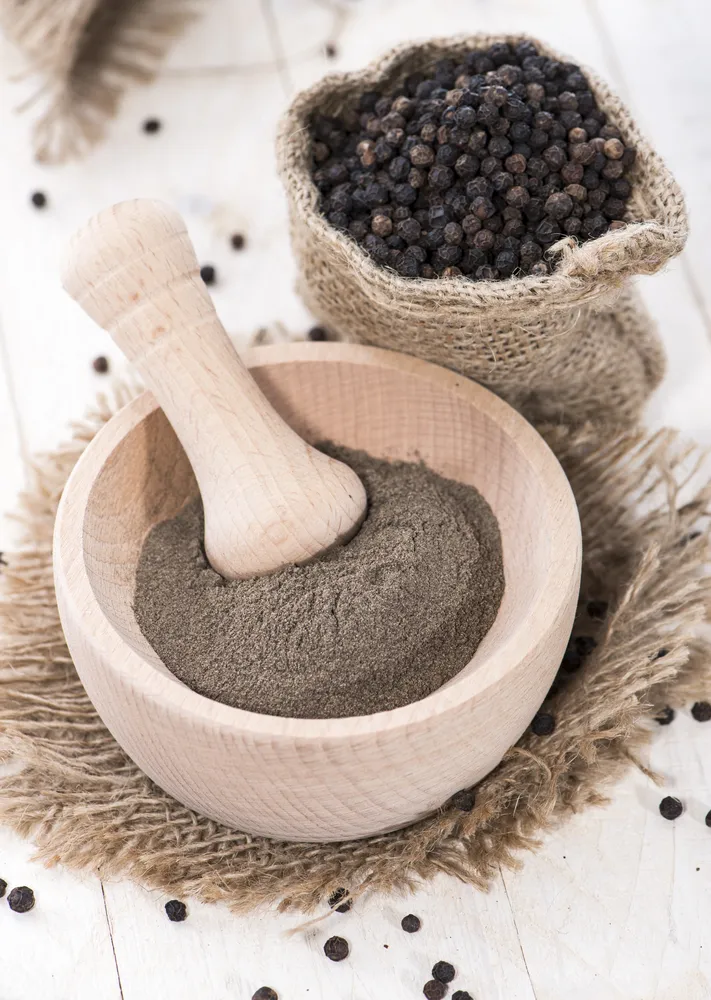Pepper

Foundation
Pepper is regularly portrayed as the "lord of flavors," and it shares a place on most supper tables with salt. The word pepper began from the Sanskrit word pippali, which means berry. Pepper is presently developed in Indonesia, Malaysia, Sri Lanka, Vietnam, and Kampuchea and in addition the West shoreline of India, known as Malabar, where it started. The United States is the biggest shipper of pepper. India is as yet the biggest exporter of the zest, and Brazil might be among the most current exporter of pepper.
Both high contrast pepper originate from the bush named Piper nigrum. Flute player nigrum is one of around 1,000 animal types in the Piper sort that is a piece of the bigger group of peppers called Piperaceae. The different types of Piper are developed for the most part as woody bushes, little trees, and vines in the tropical and subtropical areas of the world. The Piper nigrum is a climbing bush that develops to around 30 ft (9 m) tall through an arrangement of elevated roots, however is normally pruned to 12 ft (3.66 m) in development. Its blooms are thin, thick spikes with around 50 blooms each. The berry-like natural products it produces move toward becoming peppercorns; every one is around 0.2 in (5 mm) in measurement and contains a solitary seed. It is indigenous to southern India and Sri Lanka, and has been developed in different nations with consistently warm temperatures and with sodden soil conditions. Since the plant likewise loves shade, it is once in a while developed blended inside espresso and tea manors. Each plant may deliver berries for a long time.
The hot taste sensation in pepper originates from a gum called chavicine in the peppercorns. Peppercorns likewise are the wellspring of other warmth creating substances, including an alkaloid called piperine, which is utilized to add the impactful impact to cognac, and an oil that is refined from the peppercorns for use in meat sauces.
As a characteristic therapeutic operator, dark pepper in tea shape has been credited for easing joint pain, sickness, fever, headache migraines, poor absorption, strep throat, and even trance like state. It has additionally been utilized for non-restorative applications as a bug spray. Obviously, dark pepper is a most loved zest of cooks in light of its dull shading and impactful fragrance and flavor.
White pepper is likewise ordinarily utilized and is prevalent among gourmet specialists for its marginally milder flavor and the light shading that compliments white sauces, mayonnaise, souffles, and other light-hued dishes. White pepper is likewise evident pepper that is prepared in the field uniquely in contrast to its dark shape.

A blend of high contrast peppercorns is known as a mignonette. Ground pepper is additionally well known in blends of flavors. A French flavor mix called quartre epices comprises of white pepper, cloves, cinnamon, and either nutmeg or mace. Kitchen pepper is called for in a few formulas for sauces and incorporates salt, white pepper, ginger, mace, cloves, and nutmeg. Pepper, subsequently, turns out to be an adaptable and basic fixing in mix with different flavors, and in addition in lone brilliance in the pepper process.
Different types of peppers, for example, P. Iongum, P. cubeba, and P. guineense, create peppercorns that are utilized locally for restorative purposes, or are made into oleoresins, fundamental oils, or utilized as an adulterant of dark pepper. Berries of pepper trees from the variety Schinus, family Euphorbiaceae, are not genuine peppers, but rather are regularly joined with genuine peppercorns for their shading, as opposed to their flavor. S. terebinthifolius is the wellspring of pink peppercorns, however should be utilized sparingly, on the grounds that they are poisonous if eaten in substantial amount.
Betel leaf (P. betel) biting, rehearsed by the Malays of Malaysia and Indonesia, is as prevalent as cigarette smoking in that area. Biting the leaves helps assimilation, diminishes sweat, and increments physical perseverance.
Chime, cayenne, and bean stew peppers are not individuals from the Piper variety. They are characterized inside the family Solanacene, ordinarily known as nightshades. Included more than 2,000 species, the nightshade family is indigenous to Central and South America, albeit numerous species have been developed around the world. Normal nightshade species incorporate potatoes, eggplant, tomatoes, tobacco, and petunia.
History


Pepper was an essential piece of the zest exchange amongst India and Europe as right on time as Greek and Roman circumstances. Pepper remained generally obscure in Western Europe until the Middle Ages. Amid that time, the Genoese and Venetians cornered ocean exchange courses and, in this way, likewise consumed offer of pepper and different flavors.
Learning of pepper genuinely bloomed amid the European time of investigation that started in the late fifteenth century. Pepper develops in hot, muggy conditions close ocean level, such a large number of the zones where pepper develops were just obscure to Europeans until nautical, investigating, and realm building started. What's more, European tastes supported the "sweet pot," in which both sweet and appetizing fixings were cooked in a solitary pot on the hearth. The flavors utilized frequently for this sort of cooking were nutmeg, cinnamon, mace, ginger, and cloves.
The pepper that was known in Europe from Roman circumstances was the Piper longum (or long pepper) that is more fragrant and not all that hot. Our well-known dark pepper, or Piper nigrum, ascended in prominence when the stove was presented for cooking and sweet and exquisite sustenances could be arranged independently. Europeans esteemed pepper profoundly in the Middle Ages and the Renaissance, and pepper was regularly displayed for blessings, lease, endowments, rewards, and to pay charges.
Portuguese voyager Vasco da Gama achieved India in 1497 and opened the exchange course for pepper, among numerous different flavors. Then, on the opposite side of the world, Christopher Columbus found the New World, and simultaneously, he made life confounded for pepper darlings. Columbus found a vast and sweet-smelling berry he named "the Jamaican Pepper." This berry is widely utilized as a ground zest today, yet it is called allspice. His second peppery disclosure was the capsicum. Its expansive, mellow seasoned adaptations come in red, yellow, and green assortments; and it likewise incorporates these three hues in red hot stew peppers. The capsicum peppers are not identified with the pepper found in shakers and plants. Cayenne pepper is ground from dried capsicums, so it likewise isn't an assortment of the dried berry.
To add further to the disarray Columbus accidentally released, the Spanish word for pepper is pimento; so the little bits of red pimento found in olives are red pepper pieces, and allspice is otherwise called Jamaican pimento. Allspice, as this rendition of its name states, has a scent that proposes a blend of cinnamon, nutmeg, cloves, and pepper. A couple of entire allspice berries added to the supper table pepper plant will flavor up ground pepper.
Crude Materials
Peppercorns are the main crude material for both high contrast pepper in any shape. On the off chance that the maker produces green peppercorns, brackish water comprising of unadulterated water, salt, and additives is utilized. Green peppercorns are additionally pressed in vinegar; the vinegar or salt water ought to be washed off the berries previously the peppercorns are utilized as a part of cooking.
The Manufacturing Process

Cultivation

1 The pepper berries develop on shrubs that are developed to statures of around 13 ft (4 m). In the event that the berries were permitted to age completely, they would turn red; rather, they are gathered when they are green. Gathering is managed with no mechanical hardware. Ladies pick the unripened berries and transport them in extensive wicker containers to drying stages. The berries are spread on these extensive stages to dry in the sun over a time of about a week and a half. In their dried express, the green berries darken to wind up the peppercorns we use in pepper plants.
2 Alternatively, the pepper berries can be picked similarly as they turn red. They are dove into bubbling water for around 10 minutes, and they hand dark or dull darker over 60 minutes. The peppercorns are spread in the sun to dry for three to four days before they are taken to the manufacturing plant to be ground. This procedure is snappier than airdrying alone however requires the additional progression of the bubbling water shower.
3 If white pepper is to be delivered, the peppercorns are either put away in loads after they have been bubbled or they are reaped and stuffed in extensive sacks that are then brought down into running streams for seven to 15 days (contingent upon area). Bacterial activity causes the external husk of every peppercorn, called the pericarp, to split far from the rest of the peppercorn. The berries are expelled from the stream and set in barrels incompletely submerged in water; specialists stomp the berries, much like stepping grapes, to foment the peppercorns and evacuate any residual husks. A few processors now utilize mechanical strategies to pound off the external covering to create alleged decorticated pepper, yet numerous exporters lean toward the antiquated technique.
In the industrial facility
4 Black and white pepper are handled in the industrial facility by cleaning, crushing, and bundling. Blowers and gravity separators are utilized to evacuate tidy, soil hunks, bits of twigs and stalk, and different contaminations from the peppercorns after they are foreign made from the field. Once in a while, medicines are utilized to take out microorganisms on the cleaned, dry peppercorns.
5 Grinding comprises of utilizing a progression of rollers in a procedure called cool move processing to smash the peppercorns. Split peppercorns are just smashed softly to wound the peppercorns and discharge their flavor. Additionally granulating advances smash peppercorns into coarse and fine crushes of pepper that are bundled independently. A sifter sorts the grains by size, and they are passed on to bundling stations. Bundling changes broadly among processors and incorporates sacks, boxes, and canisters for substantial volume business deals and littler containers, jars, and plants for home utilize. Pressing may likewise incorporate the mixing of pepper with different flavors in an assortment of zest blends for planning sauces, cajun formulas, Italian sustenances, fish, and a scope of differents
Quality Control
Since pepper is reaped by hand, quality control starts in the field with the watchful perceptions of the gatherers. Mass importation of peppercorns is checked, as with every single rural item, by government assessors. In the plant, apparatus used to process pepper is basic, and the handling is watched all through.
The Future
The life of the flavor called pepper appears ensured. Since 1950, utilization of pepper in the United States has ascended from around 14,000-30,000 tons (12,700-27,200 metric tons) every year. Enthusiasm for gourmet cooking, in sorts of cooking like cajun-style formulas that are zest subordinate, in eatery feasting, and in fortifying nourishment arrangement have all started recharged energy for the flavor and integrity of pepper. Pepper will most likely have a respected place at the table insofar as there are cooks, kitchens, and taste-cognizant customers.
Where to Learn More
Books
Heinerman, John. The Complete Book of Spices: Their Medical, Nutritional and Cooking Uses. New Canaan, Connecticut: Keats Publishing Inc., 1983.
Norman, Jill. The Complete Book of Spices: A Practical Guide to Spices and Aromatic Seeds. New York: Viking Studio Books, 1990.
Stobart, Tom. The International Wine and Food Society's Guide to Herbs, Spices and Flavorings. New York: McGraw-Hill Book Co., 1970.
Walker, Jane. Creative Cooking with Spices: Where They Come From & How to Use Them. London: Quintet Publishing Ltd., 1985.
Periodicals
Ee, Khoo Joo. "The life of spice; cloves, nutmeg, pepper, cinnamon." UNESCO Courier (June 1984): 20.
Wemick, Robert. "Men launched 1,000 ships in search of the dark condiment." Smithsonian (February 1984): 128.
Other
Hela Spice Co. "The History of Spices." http://arcos.org/hela (March 24, 1999).
India Spice Board. http://www.indianspices.com (March 24, 1999).
McCormick & Company, Inc. March 24, 1999. http://www.mccormick.com (March 24, 1999).
—GillianS.Holmes
